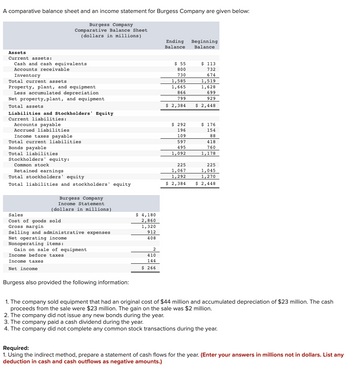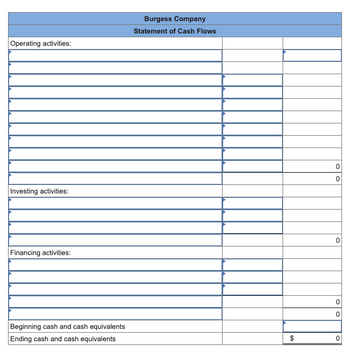
FINANCIAL ACCOUNTING
10th Edition
ISBN: 9781259964947
Author: Libby
Publisher: MCG
expand_more
expand_more
format_list_bulleted
Concept explainers
Topic Video
Question

Transcribed Image Text:A comparative balance sheet and an income statement for Burgess Company are given below:
Burgess Company
Comparative Balance Sheet
(dollars in millions)
Assets
Current assets:
Cash and cash equivalents
Accounts receivable.
Inventory
Total current assets
Property, plant, and equipment
Less accumulated depreciation
Net property, plant, and equipment.
Total assets
Liabilities and Stockholders' Equity
Current liabilities:
Accounts payable
Accrued liabilities.
Income taxes payable
Total current liabilities
Bonds payable
Total liabilities.
Stockholders' equity:
Common stock
Retained earnings
Total stockholders' equity
Total liabilities and stockholders' equity
Burgess Company
Income Statement
(dollars in millions)
Sales
Cost of goods sold
Gross margin
Selling and administrative expenses
Net operating income.
Nonoperating items:
Gain on sale of equipment
Income before taxes.
Income taxes
Net income
Burgess also provided the following information:
$ 4,180
2,860
1,320
912
408
2
410
144
$ 266
Ending
Balance
$ 55
800
730
1,585
1,665
866
799
$ 2,384
$ 292
196
109
597
495
1,092
225
1,067
1,292
$ 2,384
Beginning
Balance
$ 113
732
674
1,519
1,628
699
929
$ 2,448
$ 176
154
88
418
760
1,178
225
1,045
1,270
$ 2,448
1. The company sold equipment that had an original cost of $44 million and accumulated depreciation of $23 million. The cash
proceeds from the sale were $23 million. The gain on the sale was $2 million.
2. The company did not issue any new bonds during the year.
3. The company paid a cash dividend during the year.
4. The company did not complete any common stock transactions during the year.
Required:
1. Using the indirect method, prepare a statement of cash flows for the year. (Enter your answers in millions not in dollars. List any
deduction in cash and cash outflows as negative amounts.)

Transcribed Image Text:Operating activities:
Investing activities:
Financing activities:
Beginning cash and cash equivalents
Ending cash and cash equivalents
Burgess Company
Statement of Cash Flows
GA
0
0
0
0
0
0
Expert Solution
This question has been solved!
Explore an expertly crafted, step-by-step solution for a thorough understanding of key concepts.
Step by stepSolved in 2 steps

Knowledge Booster
Learn more about
Need a deep-dive on the concept behind this application? Look no further. Learn more about this topic, accounting and related others by exploring similar questions and additional content below.Similar questions
- Comparative financial statements for Weaver Company follow: Weaver Company Comparative Balance Sheet at December 31 Assets Cash Accounts receivable Inventory Prepaid expenses Total current assets Property, plant, and equipment Less accumulated depreciation Net property, plant, and equipment Long-term investments Total assets Liabilities and Stockholders' Equity Accounts payable Accrued liabilities. Income taxes payable. ES Total current liabilities no Bonds payable Total liabilities. Common stock Retained earnings Total stockholders' equity Total liabilities and stockholders' equity Weaver Company Income Statement For This Year Ended December 31 Sales Cost of goods sold Gross margin Selling and administrative expenses Net operating income Nonoperating items: Gain on sale of investments. Loss on sale of equipment Income before taxes Income taxes Net income Required 1 Required 2 $13 (3) Adjustments to a cash basis: This Year Last Year $4 $ 16 370 260 125 180 4 2 Adjustments to a cash…arrow_forwardSelected current year company information follows: Net income. Net sales Total liabilities, beginning-year Total liabilities, end-of-year Total stockholders' equity, beginning-year Total stockholders' equity, end-of-year The total asset turnover is: (Do not round Intermediate calculations.) $ 16,753 720,855 91,932 111, 201 206,935 133,851arrow_forwarduse the following information to make a Common size income statementarrow_forward
- The balance sheet for Altoid Company is shown below. ALTOID COMPANY Balance Sheet December 31, 2024 Assets: Cash Short-term investments Accounts receivable (net) Inventory Property, plant, and equipment (net) Total assets Liabilities and shareholders' equity: Current liabilities Long-term liabilities Common stock Retained earnings Total liabilities and shareholders' equity $ 250 700 800 950 1,170 $ 3,870 $ 950 1,100 650 1,170 $ 3,870 Selected 2024 income statement information for Altoid Company includes: Net Sales Operating expenses $ 8,700 7,770 Income before interest and tax 930 130 Income tax expense 240 Net income $ 560 Interest expense Required: Compute Altoid Company's long-term debt to equity ratio for 2024 Note: Round your answer to 2 decimal places. Long-term debt to equityarrow_forwardThe financial statements for Armstrong and Blair companies for the current year are summarized below: Blair Company Statement of Financial Position Cash Accounts receivable (net) Inventory Property, plant, and equipment (net) Other non-current assets Total assets Current liabilities. Long-term debt (10%) Share capital Contributed surplus Retained earnings Total liabilities and shareholders' equity Statement of Earnings Sales revenue (1/3 on credit) Cost of sales Expenses (including interest and income tax) Net earnings Accounts receivable (net) Inventory Long-term debt Other data: Share price year-end Income tax rate Dividends declared and paid Shares Outstanding $ Selected data from the financial statements for the previous year follows: Blair Company Armstrong Company 30,000 82,000 94,000 $ 50,000 28,000 86,000 $ $ 18 30% 46,000 15,000 Armstrong Company $ 36,000 $ 32,000 30,000 40,000 205,000 35,000 170,000 95,000 $ 536,000 $ 125,000 94,000 180,000 40,000 97,000 $ 536,000 $ 550,000…arrow_forwardSome recent financial statements for Smolira Golf, Incorporated, follow. Assets Current assets Cash Accounts receivable Inventory Total Fixed assets Net plant and equipment Total assets Sales Cost of goods sold Depreciation EBIT Interest paid Taxable income Taxes SMOLIRA GOLF, INCORPORATED 2022 Income Statement Net income Dividends Retained earnings 2021 Short-term solvency ratios a. Current ratio b. Quick ratio c. Cash ratio Asset utilization ratios d. Total asset turnover e. Inventory turnover f. Receivables turnover Long-term solvency ratios g. Total debt ratio h. Debt-equity ratio i. Equity multiplier j. Times interest earned ratio k. Cash coverage ratio Profitability ratios I. Profit margin m. Return on assets n. Return on equity $3,061 4,742 12,578 $ 20,381 SMOLIRA GOLF, INCORPORATED Balance Sheets as of December 31, 2021 and 2022 2022 Liabilities and Owners' Equity Current liabilities Accounts payable Notes payable Other $ 52,746 $ 73,127 2021 $ 188,370 126, 703 5,283 $ 56,384…arrow_forward
- Dec. 31, 2020 Dec. 31, 2019 Assets Current assets: Cash and cash equivalents $248,005 $419,465 Accounts receivable 38,283 34,839 Inventory 15.043 15,332 Prepaid expenses and other current assets 39,965 34,795 Income tax receivable 58,152 16,488 Investments 415,199 338,592 Total current assets 814.647 859,511 Property, plant, & equipment, net 1,217.220 1,106,984 Long-term investments 622,939 496.106 Other assets 70,260 64,716 Total assets $2,725,066 $2,527,317 Liabilities and Shareholders' Equity Current liabilities: Accounts payable $85,709 $69,613 Accrued payroll and benefits 64,958 73,894 Accrued liabilities 129,275 102,203 Total current liabilities 279,942 245,710 Deferred liabilities 284.267 240,975 Other liabilities 32.883 28,263 Total liabilities 597,092 514,948 Shareholders' equity: Common stock 358 354 Additional paid-in capital 954,988 861.843 Retained earnings 1,172.628 1,150,172 Total shareholders' equity 2,127,974 2,012.369 Total liabilities and shareholders' equity…arrow_forwardPlease provide answer in text (Without image)arrow_forwardSelected data from the comparative statements of financial position of Granger Ltd. are shown below: Cash Accounts receivable Inventory Property, plant, and equipment Intangible assets Total assets Cash Accounts receivable Inventory 2024 Property, plant, and equipment $152,000 606,000 783,000 3,144,000 92,000 2023 $177,000 400,000 595,000 2,793,000 98,000 $4,777,000 $4,063,000 2024 Using horizontal analysis, calculate the percentage of a base-year amount, assuming 2022 is the base year. (Round answers to 1 decimal place, e.g. 5.2%.) % % % 2022 % $75,000 453,000 706,000 2,863,000 0 $4,097,000 2023 % % % % 2022arrow_forward
- Based on the above information, analyze the changes in the company's profitability and liquidity, in addition to the management of accounts receivable and inventory from 2022 to 2024. (Round answers to 1 decimal place, eg 13.5% or 13.5.) 2023 Sales Cost of goods sold Gross margin Other expenses Income taxes Net income Current ratio Quick ratio A/R turnover Average collection period Inventory turnover Days to sell inventory Debt to equity Return on assets 2022 Return on equity % 2022 % % 2022 :1 :1 times days times days 56 2023 % % % 2023 times days times days 2024 Based on the above information, analyze the company's use of leverage from 2022 to 2024. (Round answers to 1 decimal place, eg 15.1%) % 2024 % % % 2024arrow_forwardWhat's the total asset turnover ratio of this company? Assets: Cash and marketable securities Accounts receivable Inventories Prepaid expenses Total current assets Fixed assets Less: accum. depr. Net fixed assets Total assets Liabilities: Accounts payable Notes payable Accrued taxes Total current liabilities Long-term debt Owner's equity (1 million shares of common stock outstanding) Total liabilities and owner's equity Net sales (all credit) Less: Cost of goods sold Selling and administrative expense Depreciation expense Interest expense Earnings before taxes Income taxes Net income 1.41 2.33 O 4.45 1.11 8,000,000 (2,075,000) $600,000 900,000 1,500,000 75,000 $3,075,000 $5,925.000 $9,000,000 $800,000 700,000 50,000 $1,550,000 2,500,000 4,950,000 $9,000,000 $10,000,000 (3,000,000) (2,000,000) (250,000) (200,000) 4,550,000 (1,820,000) $2,730,000arrow_forwardThe balance sheets for Dual Monitors Corporation and additional information are provided below. DUAL MONITORS CORPORATION Balance Sheets December 31, 2024 and 2023 Assets. Current assets: Cash Accounts receivable Inventory Investments Long-term assets: Land Equipment Less: Accumulated depreciation Total assets Liabilities and Stockholders' Equity Current liabilities: Accounts payable Interest payable. Income tax payable Long-term liabilities: Notes payable Stockholders' equity: Common stock Retained earnings Total liabilities and stockholders' equity Additional information for 2024: 1. Net income is $91,560. 2. Sales on account are $1,416,800. (All sales are credit sales.) 3. Cost of goods sold is $1,098,500. 2024 $149,560 72,000 92,000 3,700 450,000 760,000 2023 450,000 640,000 (398,000) (238,000) $1,129,260 $1,136,700 $95,400 6,000 8,000 $117,000 89,000 77,000 1,700 $82,000 11,700 4,700 220,000 670,000 148,300 110,000 670,000 239,860 $1,129,260 $1,136,700 Required: 1. Calculate the…arrow_forward
arrow_back_ios
SEE MORE QUESTIONS
arrow_forward_ios
Recommended textbooks for you

 AccountingAccountingISBN:9781337272094Author:WARREN, Carl S., Reeve, James M., Duchac, Jonathan E.Publisher:Cengage Learning,
AccountingAccountingISBN:9781337272094Author:WARREN, Carl S., Reeve, James M., Duchac, Jonathan E.Publisher:Cengage Learning, Accounting Information SystemsAccountingISBN:9781337619202Author:Hall, James A.Publisher:Cengage Learning,
Accounting Information SystemsAccountingISBN:9781337619202Author:Hall, James A.Publisher:Cengage Learning, Horngren's Cost Accounting: A Managerial Emphasis...AccountingISBN:9780134475585Author:Srikant M. Datar, Madhav V. RajanPublisher:PEARSON
Horngren's Cost Accounting: A Managerial Emphasis...AccountingISBN:9780134475585Author:Srikant M. Datar, Madhav V. RajanPublisher:PEARSON Intermediate AccountingAccountingISBN:9781259722660Author:J. David Spiceland, Mark W. Nelson, Wayne M ThomasPublisher:McGraw-Hill Education
Intermediate AccountingAccountingISBN:9781259722660Author:J. David Spiceland, Mark W. Nelson, Wayne M ThomasPublisher:McGraw-Hill Education Financial and Managerial AccountingAccountingISBN:9781259726705Author:John J Wild, Ken W. Shaw, Barbara Chiappetta Fundamental Accounting PrinciplesPublisher:McGraw-Hill Education
Financial and Managerial AccountingAccountingISBN:9781259726705Author:John J Wild, Ken W. Shaw, Barbara Chiappetta Fundamental Accounting PrinciplesPublisher:McGraw-Hill Education


Accounting
Accounting
ISBN:9781337272094
Author:WARREN, Carl S., Reeve, James M., Duchac, Jonathan E.
Publisher:Cengage Learning,

Accounting Information Systems
Accounting
ISBN:9781337619202
Author:Hall, James A.
Publisher:Cengage Learning,

Horngren's Cost Accounting: A Managerial Emphasis...
Accounting
ISBN:9780134475585
Author:Srikant M. Datar, Madhav V. Rajan
Publisher:PEARSON

Intermediate Accounting
Accounting
ISBN:9781259722660
Author:J. David Spiceland, Mark W. Nelson, Wayne M Thomas
Publisher:McGraw-Hill Education

Financial and Managerial Accounting
Accounting
ISBN:9781259726705
Author:John J Wild, Ken W. Shaw, Barbara Chiappetta Fundamental Accounting Principles
Publisher:McGraw-Hill Education